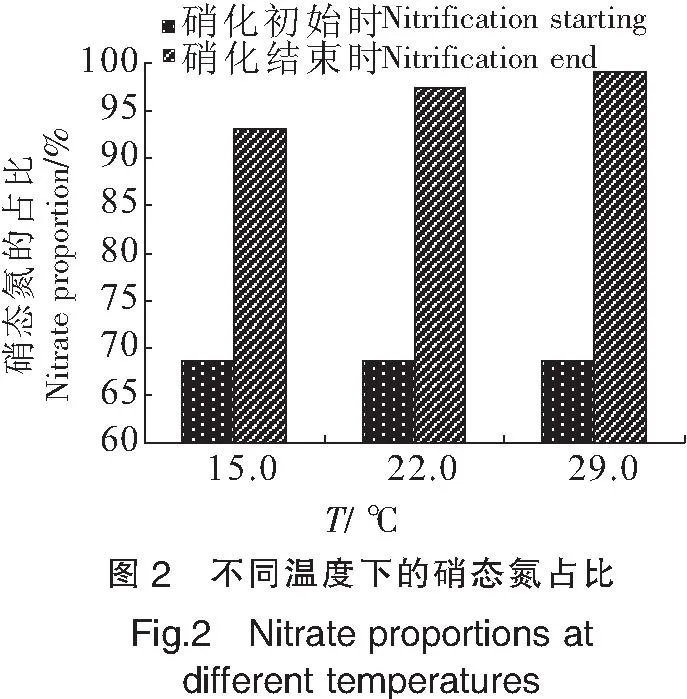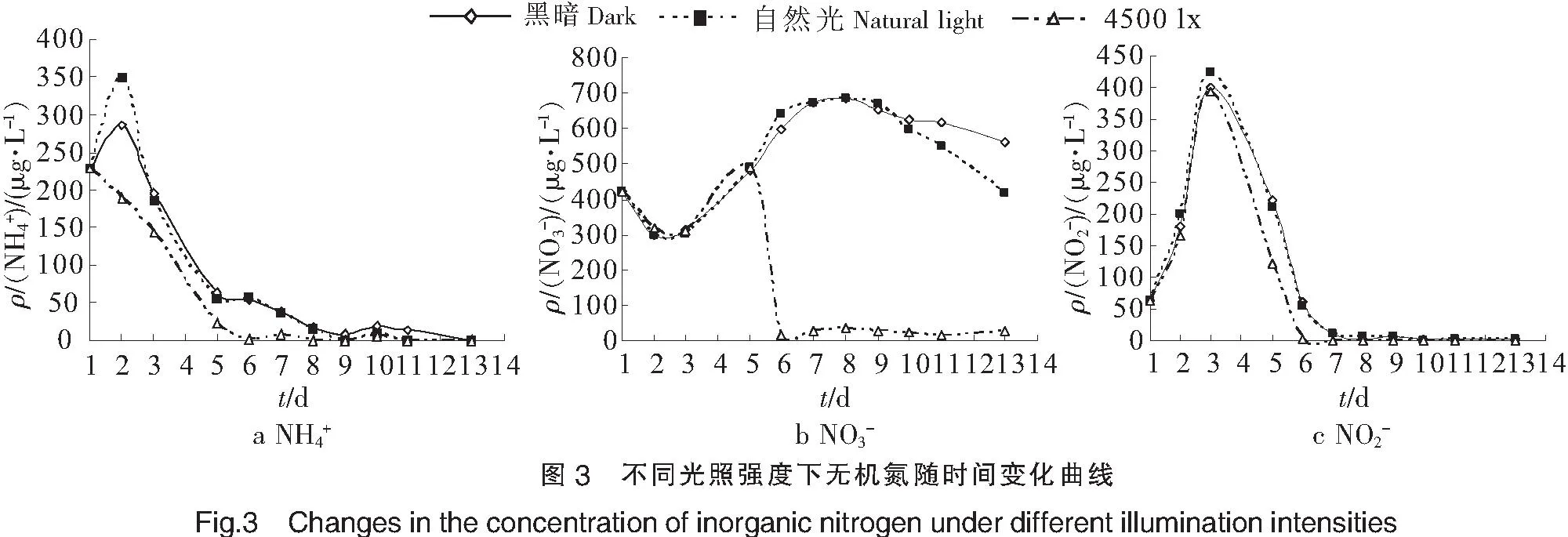温度、光照强度和盐度对近海养殖水体硝化作用的影响
蔡真珍,郑盛华,王 宪
(1.厦门海洋职业技术学院,福建 厦门 361002;2.福建省水产研究所,福建 厦门 361013;
3.厦门大学海洋与地球学院,福建 厦门 361005)
温度、光照强度和盐度对近海养殖水体硝化作用的影响
蔡真珍1,郑盛华2,王宪3
(1.厦门海洋职业技术学院,福建 厦门 361002;2.福建省水产研究所,福建 厦门 361013;
3.厦门大学海洋与地球学院,福建 厦门 361005)
[摘要]采集近海养殖水体,在实验室进行不同温度、光照强度、盐度的模拟培养,考察环境因子对硝化作用的影响.结果表明:在15.0~29.0 ℃范围内,养殖水体温度越高,硝化作用进行得越快、越完全;黑暗和自然光条件对硝化作用影响不大,而4500 lx下则明显被吸收;盐度18的养殖水体对亚硝化有抑制现象,但硝化作用仍进行得较完全;在盐度36下的硝化作用受到一定程度的抑制.
[关键词]温度;光照强度;盐度;近海;养殖;水体;硝化作用
0引言

当前,养殖水域环境污染的加重限制了水产养殖业的可持续发展,硝化作用是近海养殖系统中氨氮污染治理的有效途径,而文献中对其影响因素的深入研究报道较少.本文通过在不同温度、光照强度、盐度下的实验室模拟培养,探讨环境因子对近海养殖水体硝化作用的影响,以期为近海养殖海域生态系统的改善提供理论研究基础.
1材料与方法
1.1 仪器与试剂
S-10E盐度折射计(日本ATAGO公司);GXZ-260C智能光照培养箱(宁波江南仪器厂);M-104充氧泵(马来西亚KWZONE公司);Spectrum 722可见分光光度计、752型紫外光栅分光光度计(上海精密科学仪器有限公司).
NaNO2、磺胺、浓盐酸、盐酸萘乙二胺、KNO3、CdCl2、NH4Cl、K2S2O3、KBrO3、KBr、锌卷均为分析纯;NaCl、MgSO4·7H2O、NaOH均为优级纯.
1.2 实验方法


在其他环境参数不变的情况下,温度梯度的设置为15.0,22.0,29.0 ℃; 光照强度梯度的设置为黑暗、自然光照(12h∶12h)、4500lx; 盐度梯度的设置为18,27,36.
2结果
2.1 温度对硝化作用的影响
2.1.1不同温度下无机氮的变化趋势




2.1.2不同温度下的硝态氮占比
如图2所示,经计算得到,硝化初始时水体中硝态氮占总无机氮的比例为68.61%,在硝化结束后,15.0 ℃、22.0 ℃、29.0 ℃下硝态氮占比分别为93.17%、97.35%、99.22%.

2.2 光照强度对硝化作用的影响
2.2.1不同光照强度下无机氮的变化趋势



2.2.2不同光照强度下的硝态氮占比

2.3 盐度对硝化作用的影响
2.3.1不同盐度下无机氮的变化趋势




2.3.2不同盐度下的硝态氮占比
经计算得(见图6),在盐度18、27、36下硝态氨在总无机氮中的占比分别为99.38%、99.39%、97.92%(硝化初始时为67.93%),硝化作用均进行得较完全,且盐度36的水体硝态氮占比为3种盐度中最低.

3讨论
1)温度是影响微生物生长代谢的重要环境因子之一,直接影响微生物对物质的吸收和利用.对于硝化作用而言,温度可能会影响硝化细菌的活性,从而对反应造成影响.王淑莹等[8]报道,在不同温度(10,15,20,25,30 ℃)下,随着温度升高,污泥中的硝化速率加快.周玲玲等[9]的研究表明,在生物膜培养反应器模拟给水管网系统中,30 ℃时硝化作用显著而15 ℃时不明显.徐敏等[10]指出,海洋硝化细菌在20~35 ℃时对氨氮的去除率均较高,但在40 ℃时去除效果较差.WangLing等[11]的研究指出,人工湿地里的硝化细菌对四季温度有较强的适应性.FontenotQ.等[12]的研究指出,废水中硝化作用的最适温度是22~37 ℃.YooH.等[13]的研究表明,亚硝化反应的最佳温度是22~27 ℃,或至少不能低于15 ℃.



4结论
1)在15.0~29.0 ℃的范围内,温度升高对近海养殖水体的硝化作用有明显的促进作用.

3)盐度在18~36的范围内,盐度18对近海养殖水体的亚硝化阶段有抑制,但对硝化作用的反应完全程度无影响;而在盐度36下的硝化作用则受到一定程度的抑制.
[参考文献]
[1]张卫强,朱英.养殖水体中氨氮的危害及其检测方法研究进展[J].环境卫生学杂志,2012,2(6):324-327.
[2]LU S M,LIAO M J,XIE C X.Removing ammonium from aquaculture ponds using suspended biocarrier-immobilized ammonia-oxidizing microorganisms[J].Annals of Microbiology,2015,65(4):2041-2046.
[3]JAMES J P,MARTIN T A.Nitrification in the water column and sediment of a hypereutrophic lake and adjoining river system[J].Water Research,2000,34(4):1247-1254.
[4]WANG C,ZHAI W Y,YIN W,et al.The limiting role of oxygen penetration in sediment nitrification[J].Environmental Science and Pollution Research,2015,22(14):10910-10918.
[5]徐继荣,王友绍,殷建平,等.大亚湾海域沉积物中的硝化与反硝化作用[J].海洋与湖沼,2007,38(3):206-211.
[6]陈国元.NH3-N浓度对太湖竺山湾水体及沉积物中硝化作用的影响[J].水生态学杂志,2012,33(2):55-60.
[7]中华人民共和国国家质量监督检验检疫总局,中国国家标准管理委员会.海洋监测规范:GB 17378.4—2007[S].
[8]王淑莹,刘旭,吴蕾.温度和游离氨对颗粒与絮状污泥硝化性能影响的对比研究[J].北京工业大学学报,2013,39(2):297-303.
[9]周玲玲,张永吉,宋正国,等.pH和温度对氯胺消毒给水管网硝化作用的影响[J].环境科学,2011,32(6):1627-1631.
[10]徐敏,牛越,昌晶,等.几种理化因子对海洋硝化细菌去除氨氮效果的影响[J].微生物学杂志,2007,2(5):65-69.
[11]WANG L,LI T.Effects of seasonal temperature variation on nitrification,anammox process,and bacteria involved in a pilot-scale constructed wetland[J].Environmental Science and Pollution Research,2015,22(5):3774-3783.
[12]FONTENOT Q,BONVILLAIN C,KILGEN M,et al.Effects of temperature,salinity,and carbon:nitrogen ratio on sequencing batch reactor treating shrimp aquaculture wastewater[J].Bioresource Research,2007,98(9):1700-1703.
[13]YOO H,AHN K H,LEE H J,et al.Nitrogen removal from synthetic wastewater by simultaneous nitrification and denitrification (SND) via nitrite in an intermittently-aerated reactor[J].Water Research,1999,33(1):145-154.
[14]方涛,贺心然,冯志华,等.光照对微藻在海水中吸收氮磷营养盐的影响[J].淮海工学院学报(自然科学版),2012,21(2):80-83.
[15]操家顺,单淇.光照强度对光能自养生物膜去除低污染水体中硝态氮的影响研究[J].环境污染与防治,2013,35(3):15-19.
[16]程丽巍,邹定辉,郑青松.光照和温度对氮饥饿及饱和营养条件下石莼(Ulva lactuca)的硝态氮吸收动力学影响[J].生态学杂志,2010,29(5):939-944.
[17]ZHANG S,KIM T H,HAN T H,et al.Influence of light conditions of a mixture of red and blue light sources on nitrogen and phosphorus removal in advanced wastewater treatment using Scenedesmus dimorphus[J].Biotechnology and Bioprocess Engineering,2015,20(4):760-765.

[19]ENOKSSON V,FOGELQUIST E,FONSELIUS S.Nitrogen speciation and nitrification potential in the Skagerrak area during the SKAGEX IV experiment [J].Deep Sea Research I,1996,43:1029-1044.

[21]KRISHNAN K P,SINHA R K,RAJAN S.Pelagic nitrification and denitrification rates in an Arctic fjord during early spring[J].Annals of Microbiology,2014,64(1):365-376.
[22]LIPSCHULTZ F,WOFSY S C,FOX L E.The effects of light and nutrients on rates of ammonium transformation in a eutrophic river[J].Fox Marine Chemistry,1985,16(4):329-341.

[25]吕艳华,白洁,姜艳.黄河三角洲湿地硝化作用强度及影响因素研究[J].海洋湖沼通报,2008(2):61-66.
(责任编辑朱雪莲英文审校刘静雯)
Influence of Temperature,Illumination Intensity and Salinity onNitrification in Coastal Aquaculture WaterCAI Zhen-zhen1,ZHENG Sheng-hua2,WANG Xian3
(1.Xiamen Ocean Vocational College,Xiamen 361002,China;2.Fisheries Research Institute of Fujian,
Xiamen 361013,China;3.College of Ocean & Earth Science,Xiamen University,Xiamen 361005,China)
Abstract:The effects of temperature, illumination intensity and salinity on nitrification were investigated in laboratory condition.The results indicated that the nitrification rate and nitrate proportion increased during 15.0 ℃ to 29.0 ℃.There was no evident impact on the nitrification under the condition of dark and natural lighting, while, the intrate nitrogen was uptaken obviously at the light of 4500lx. It showed that the lower salinity of 18 had no influence on the nitrification,werase the higher salinity of 36 inhibited the nitrification to a certain degree in terms of nitrification rates and nitrate proportions.
Key words:temperature;illumination intensity;salinity;coastal;aquaculture water;nitrification
[中图分类号]S 912
[文献标志码]A
[文章编号]1007-7405(2015)06-0407-07
[作者简介]蔡真珍(1983—),女,讲师,硕士,从事海洋化学、环境化学研究,E-mail:ch117@126.com.
[基金项目]福建省省属公益类科研院所基本科研专项(闽海渔科2013R001-8号);福建省渔业“五新”科技推广项目(闽海渔五新合同[2012]001号)
[收稿日期]2015-09-28[修回日期]2015-10-23

